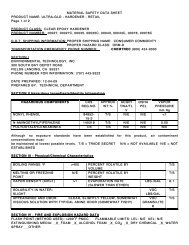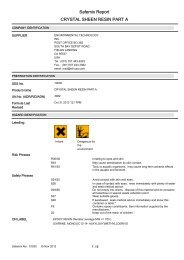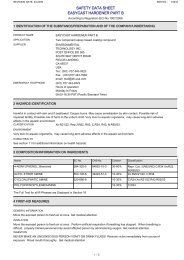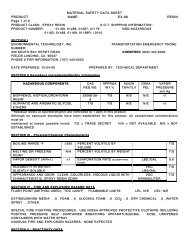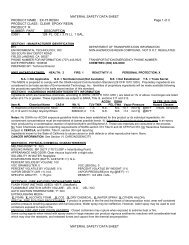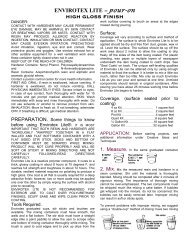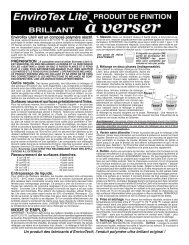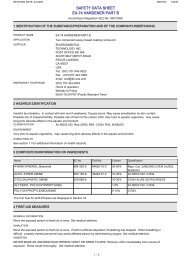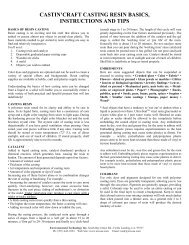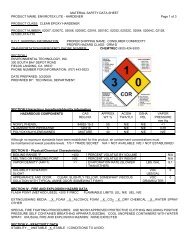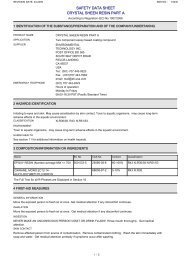EasyMold Silicone Rubber B.pdf - Environmental Technology Inc
EasyMold Silicone Rubber B.pdf - Environmental Technology Inc
EasyMold Silicone Rubber B.pdf - Environmental Technology Inc
You also want an ePaper? Increase the reach of your titles
YUMPU automatically turns print PDFs into web optimized ePapers that Google loves.
Material Safety Data SheetProduct Name: <strong>EasyMold</strong> <strong>Silicone</strong> <strong>Rubber</strong> Part BProduct Codes: 33720, 33730 Revision Date: 9/17/2010Emergency overview and potential hazards:This material is not hazardous under OSHA criteria. This material is not hazardous under WHMIScriteria.Physical Hazards:Under certain conditions this material may generate flammable hydrogen gas.Acute health effects:Route of entry or possible contact: eyes, skin , ingestion .Eye contact:May cause slight eye irritation.Skin contact:No acute toxic skin effects are expected.Inhalation:Inhalation is not expected due to low vapor pressure.Ingestion:Ingestion is not expected in industrial use.Additional information on acute health effects:The health hazard evaluation is based on test results and/or on known properties of ingredients.Chronic health effects:No known or expected chronic health effects.Medical conditions which may be aggravated by exposure:None known.Target organs affected:No known internal organ effects.Signs and Symptoms of Exposure:Refer to Acute Health Effects, listed above.Carcinogens/Reproductive toxins:This material does not contain any reproductive toxins at or above OSHA or WHMIS reportable levels.This material does not contain any reportable carcinogenic ingredients. Exposure to carcinogens cannotoccur under normal conditions of use or during foreseeable emergencies.See Section 11 for Toxicological Information, if any.4. First Aid MeasuresGeneral information:Get medical attention if irritation or other symptoms occur. Before seeking medical attention removecontaminated clothing and shoes. Take a copy of the Safety Data Sheet when going for medicaltreatment.After inhalation:No special measures required.After contact with the skin:Wipe off excess material with cloth or paper. Use a waterless hand cleaner to remove as much of theremaining material as possible. Wash with soap and water.After contact with the eyes:If contact with eyes, immediately hold eyelids apart and flush with plenty of water for at least 15 min.2
Material Safety Data SheetProduct Name: <strong>EasyMold</strong> <strong>Silicone</strong> <strong>Rubber</strong> Part BProduct Codes: 33720, 33730 Revision Date: 9/17/2010After swallowing:No special treatment is required.5. Fire Fighting MeasuresFlammable properties:Method:Flash point..........................: > 300 °C (> 572 °F) (ISO 2592)Boiling point / boiling range........: not applicableLower explosion limit (LEL)..........: not applicableUpper explosion limit (UEL)..........: not applicableIgnition temperature ................: > 450 °C (> 842 °F) (DIN 51794)NFPA Hazard Class (comb./flam. liquid): IIIBFire and explosion hazards:This material does not present any unusual fire or explosion hazards.Recommended extinguishing media:Water-mist, carbon dioxide, sand, dry chemical or alcohol-resistant foam.Unsuitable extinguishing media:Water-spray, sharp water jet.Fire fighting procedures:Fire fighters should wear full protective clothing including a self-contained breathing apparatus. Coolendangered containers with water.6. Accidental Release MeasuresPrecautions:If material is released indicate risk of slipping. Do not walk through spilled material.HAZWOPER PPE Level: DContainment:Prevent material from entering surface waters, drains or sewers and soil. Contain any fluidthat runs out using suitable material (e.g. earth). Close leak if possible without risk.Spills of material which could reach surface waters must be reported to the United States CoastGuard National Response Center's toll free phone number (800) 424-8802.Methods for cleaning up:Take up mechanically and dispose of according to local/state/federal regulations. For smallamounts: Absorb with a liquid binding material such as diatomaceous earth and dispose ofaccording to local/state/federal regulations. Contain larger amounts and pump up into suitablecontainers. Clean any slippery coating that remains using a detergent / soap solution oranother biodegradable cleaner. Apply sand or other inert granular material to improve traction.7. Handling and StorageGeneral information:Always stir well before use.3
Material Safety Data SheetProduct Name: <strong>EasyMold</strong> <strong>Silicone</strong> <strong>Rubber</strong> Part BProduct Codes: 33720, 33730 Revision Date: 9/17/2010Precautions for safe handling:Spilled substance increases risk of slipping.Precautions against fire and explosion:Observe the general rules for fire prevention.Conditions for storage rooms and vessels:None known.Advice for storage of incompatible materials:Not applicable.Further information for storage:Keep container tightly closed. Store in a dry and cool place.8. Exposure Controls and Personal ProtectionVentilation:Use with adequate ventilation.Local exhaust:Not necessary.Personal protection equipment (PPE)Respiratory protection:Respiratory protection is not normally required.Hand protection:Recommendation: Any liquid-tight rubber or vinyl gloves.Eye protection:Recommendation: Safety glasses with side shields.Other protective clothing or equipment:Additional protective clothing or equipment is not normally required. Provide eye bath andsafety shower.General hygiene and protection measures:When handling, do not eat, drink, smoke or apply cosmetics. Wash thoroughly after handling.9. Physical and Chemical PropertiesAppearance:Physical state / form: liquidColor:blueOdor:odorlessSafety parameters:Method:Melting point / melting range: not determinedBoiling point / boiling range: not applicableFlash point: > 300 °C (> 572 °F) (ISO 2592)Ignition temperature: > 450 °C (> 842 °F) (DIN 51794)Lower explosion limit (LEL): not applicableUpper explosion limit (UEL): not applicableVapor pressure:not determined4
Material Safety Data SheetProduct Name: <strong>EasyMold</strong> <strong>Silicone</strong> <strong>Rubber</strong> Part BProduct Codes: 33720, 33730 Revision Date: 9/17/2010Density: 1.01 g/cm³ at 20 °C (68 °F), at 1013 hPa (DIN 51757)Water solubility / miscibility: virtually insoluble at 20 °C (68 °F)pH-Value:not applicableViscosity (dynamic):approx. 800 mPa.s at 20 °C (68 °F) (BROOKFIELD)Thermal decomposition:> 200 °C (> 392 °F)10. Stability and ReactivityGeneral information:If stored and handled in accordance with standard industrial practices no hazardous reactionsare known.Conditions to avoid:None known.Materials to avoid:None known.Hazardous decomposition products:If stored and handled in accordance with standard industrial practices and local regulationswhere applicable: none known . Measurements have shown the formation of small amounts offormaldehyde at temperatures above about 150 °C (302 °F) through oxidation.Further information:Hazardous polymerization cannot occur.11. Toxicological InformationGeneral information:Toxicological testing has not been conducted with this material.12. Ecological InformationInformation on elimination (persistence and degradability)Biodegradation / further information:Biologically not degradable.Further information:Separation by sedimentation.Insoluble in water.Further information:Bioaccumulation is not expected to occur.Ecotoxicological effects:Evaluation on basis of physical-chemical properties: No expected damaging effects to aquaticorganisms.Effects in sewage treatment plants (bacteria toxicity: respiration-/reproduction inhibition):According to current knowledge adverse effects on water purification plants are not expected.Other harmful effects:None known.5
Material Safety Data SheetProduct Name: <strong>EasyMold</strong> <strong>Silicone</strong> <strong>Rubber</strong> Part BProduct Codes: 33720, 33730 Revision Date: 9/17/2010General information:No environmental problems expected if handled and treated in accordance with standardindustrial practices and local regulations where applicable.13. Disposal ConsiderationsProduct disposal recommendation:Material that cannot be used or chemically reprocessed should be disposed of at an approvedfacility in accordance with any applicable governmental regulations.Packaging disposal recommendation:Completely empty containers. Containers may be recycled or re-used. Observe local/state/federalregulations.14. Transportation InformationUS DOT & Canada TDG Surface:Not regulated for transport.Transport by sea IMDG-Code:Not regulated for transport.Air transport ICAO-TI/IATA-DGR:Not regulated for transport.15. Regulatory InformationU.S. Federal regulationsTSCA inventory status and TSCA information:This material or its components are listed on or are in compliance with the requirements of theTSCA Chemical Substance Inventory.TSCA 12(b) Export Notification:This material does not contain any TSCA 12(b) regulated chemicals.CERCLA Regulated Chemicals:This material does not contain any CERCLA regulated chemicals.SARA 302 EHS Chemicals:This material does not contain any SARA extremely hazardous substances.SARA 311/312 Hazard Class:This product does not present any SARA 311/312 hazards.SARA 313 Chemicals:This material does not contain any SARA 313 chemicals above de minimus levels.HAPS (Hazardous Air Pollutants):This material does not contain any hazardous air pollutants.U.S. State regulationsCalifornia Proposition 65 Carcinogens:This material does not contain any chemicals known to the state of California to cause cancer.6
Material Safety Data SheetProduct Name: <strong>EasyMold</strong> <strong>Silicone</strong> <strong>Rubber</strong> Part BProduct Codes: 33720, 33730 Revision Date: 9/17/2010California Proposition 65 Reproductive Toxins:This material does not contain any chemicals known to the state of California to causereproductive effects.Massachusetts Substance List:1309-37-1 Iron oxideNew Jersey Right-to-Know Hazardous Substance List:1309-37-1 Iron oxidePennsylvania Right-to-Know Hazardous Substance List:1309-37-1 Iron oxideCanadian regulations:This product has been classified in accordance with the Hazard criteria of the CPR and the MSDScontains all the information required by the CPR.WHMIS Hazard Classes:None.DSL Status:This material or its components are listed on the Canadian Domestic Substances List.Non-DSL Chemicals:This material does not contain any non-DSL chemicals.Canadian Ingredient Disclosure List:1309-37-1 Iron oxide16. Other InformationAdditional information:This Material Safety Data Sheet (MSDS) meets the requirements of the Federal OSHA HazardCommunication Standard (29 CFR 1910.1200). This product has been classified according to thehazard criteria of the Controlled Products Regulations (CPR) and the MSDS contains all of theinformation required by the CPR. This information relates to the specific material designatedand may not be valid for such material used in combination with any other materials or in anyprocess. Such information is to the best of our knowledge and belief accurate and reliable asof the date compiled. However, no representation, warranty or guarantee expressed or implied,is made as to its accuracy, reliability or completeness. It is the user's responsibility tosatisfy himself as to the suitability and completeness of such information for his ownparticular use. We do not accept liability for any loss or damage that may occur from the useof this information. Nothing herein shall be construed as a recommendation for uses whichinfringe valid patents or as extending a license under valid patents. This MSDS providesselected regulatory information on this product, including its components. This is not intendedto include all regulations. It is the responsibility of the user to know and comply with allapplicable rules, regulations and laws relating to the product being used.Glossary of Terms:ACGIH - American Conference of GovernmentalIndustrial HygienistsDOT - Department of TransportationhPa - Hectopascals7
Material Safety Data SheetProduct Name: <strong>EasyMold</strong> <strong>Silicone</strong> <strong>Rubber</strong> Part BProduct Codes: 33720, 33730 Revision Date: 9/17/2010mPa*s - Milli Pascal-SecondsOSHA - Occupational Safety and Health AdministrationPEL - Permissible Exposure Limitppm - Parts per MillionSARA - Superfund Amendments and Reauthorization ActSTEL - Short Term Exposure LimitTSCA - Toxic Substances Control ActTWA - Time Weighted AverageWHMIS - Canadian Workplace Hazardous Materials Identification SystemFlash point determination methods :Common name:ASTM D56Tagliabue (Tag) closed cupASTM D92, DIN 51376, ISO 2592Cleveland open cupASTM D93, DIN 51758, ISO 2719Pensky-Martens closed cupASTM D3278, DIN 55680, ISO 3679Setaflash or Rapid closed cupDIN 51755Abel-Pensky closed cupConversion table:Pressure: 1 hPa * 0.75 = 1 mm Hg = 1 Torr; 1 bar = 1000 hPaViscosity: 1 mPa*s = 1 Centipoise (Cp)8


